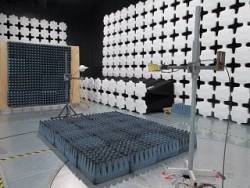
A newly posted report shows the comments federal researchers received from a dozen organizations and satellite navigation experts as they put together a plan for controversial tests of GPS receivers on behalf of would-be broadband firm Ligado.
A newly posted report shows the comments federal researchers received from a dozen organizations and satellite navigation experts as they put together a plan for controversial tests of GPS receivers on behalf of would-be broadband firm Ligado.
The tests, which are expected to be complete this fall, were developed by the National Advanced Spectrum and Communications Test Network (NASCTN) under a cooperative research and development agreement or CRADA with Ligado. Ligado is funding the work and crafted the questions to be addressed including looking at position error as a “measurand” or metric of receiver interference.
The firm wants to use frequencies neighboring those used by GPS for wireless broadband and has been advocating for using position error instead of the internationally accepted standard of changes in the signal-to-noise ratio — a shift opposed by the GPS community.
The choice of NASCTN to do the testing raised some eyebrows. The group — a national network of federal, academic, and commercial test facilities — was formed in 2015 through a memorandum of understanding between the National Institute of Standards and Technology (NIST), the Department of Defense and the National Telecommunications and Information Administration (NTIA). Though it describes itself as a neutral forum, part of NASCTN’s mission, as described on its website, is to “accelerate the deployment of wireless technologies among commercial and federal users.”
The drafting of the plan for the tests also triggered concern. The fact that tests were being developed at all was a surprise to some, and the feedback sought by NASCTN appears to have been limited — especially when compared to work done by the Department of Transportation (DoT).
DoT is close to announcing the initial results of a years-long effort to test GPS receiver interference. The DoT test plan, called the Adjacent Band Compatibility Assessment, was published in the Federal Register and was based on information from four workshops attended by an average of 96 people each. NASCTN did not use the Federal Register, it said in earlier written comments, because it wanted to take a less passive approach.
“NASCTN chose a more active and engaged approach to getting technical feedback on its test plan,” the agency wrote, “including distributing the test plan to a number of GPS manufacturers, federal agencies, and spectrum regulators resulting in 158 comments from 10 different organizations. To provide more information about the test plan and this project, NASCTN also hosted a half-day federal agency meeting and briefed the National Space-Based Positioning, Navigation and Timing (PNT) Executive Committee.”
The 52-page summary of the feedback received by NASCTN about its draft test plan lists the comments themselves and describes how they were adjudicated by the research team — although it does not reveal who made which comment. The feedback varied widely from suggestions on how the text might be made clearer to critiques such as a too-short list of receivers, a lack of satellite navigation expertise on the NASCTN team, and concerns about the overall structure of the testing.
For example, one commentator wrote that the tests "must also consider the density of the transmission sources. ‘LTE impacts on GPS’ does not mean interference from only one transmission source. There are 40,000+ transmission sources and our concern is on the interference from the network, not a single tower. The proposed density of the network in 2011 had towers every .4 — .7 km. With interference effects predicted at greater than 20 km, that means the victim receiver expects to receive interference from multiple stations simultaneously. Density of the LTE stations can’t really be ignored if the criteria is supposed to be ‘based on end-user experience.’”
In response to this comment, and more than a dozen others, NASCTN said "the scope of this NASCTN project has been negotiated in the CRADA between NIST and Ligado Networks. If additional tests are needed beyond this project, organizations are encouraged to submit project proposals to NASCTN."
That same CRADA, it appears, may also limit the data that can be shared after the testing is complete.
"The handling of proprietary information and distribution of the NASCTN report, measurement data, and data analysis is governed by the CRADA signed by NIST and Ligado Networks,” the group wrote in response to another comment. "The NASCTN report will include all of the information that is publically releasable."
Ligado did not respond by press time to a query about the data issue and the opportunity to offer its perspective about the report.
The NASCTN test team reached out directly to the following for their perspectives:
— Federal Communication Committee (FCC)
— National Telecommunications & Information Administration (NTIA)
— US Department of Transportation (DOT)
— National Aeronautics and Space Administration (NASA)
— US Air Force Space Command (AFSPC)
— US Air Force Spectrum Management Office (AFSMO)
— Deere & Company
— Garmin Ltd.
— Honorable John Stenbit, Dr. Brad Parkinson, Dr. John Betz
— Mr. Larry Chesto
Of this group Stenbit, Parkinson, and Betz are members of the National Space-Based Positioning, Navigation, and Timing (PNT) Advisory Board, the leading U.S. group providing independent advice to the U.S. government on GPS-related policy.
Deere and Garmin are GPS receiver manufacturers that, along with Trimble, were sued by Ligado’s predecessor LightSquared. These suits were settled in December and are often pointed to by Ligado as evidence that it has worked out differences with the GPS community. Although Trimble is not on the list of those who offered feedback on the draft plan, it confirmed it provided equipment for the NASCTN tests. The firm did not submit written comments.
Deere submitted comments, wrote NASCTN, but said they "were non-technical in nature and were not included in the comment adjudication. However, Deere & Company also filed these comments with the FCC."
Indeed, in its FCC filing Deere underscored some of the issues surrounding the NASCTN tests, calling into question their value given that the ABC Assessment was nearly complete. LINK https://www.insidegnss.com/node/5098
“In light of the DOT process," Deere wrote, "the NASCTN plan, however well-intentioned, falls short of a test process that would add anything of value to the extensive test record already under development in the DOT process and risks confusion and misinterpretation as an assessment intended to prove a predetermined conclusion.”





